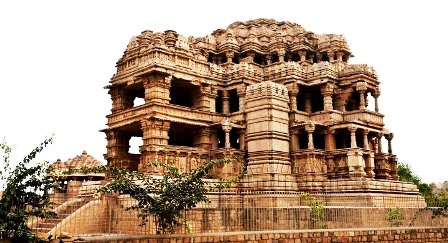- Home
- Indian Dynasties
- Gurjara Prathihara
Gurjara Prathihara in India
Gurjara Prathihara of India also known
as Prathihara Empire ruled for 400 years. They are believed to be the clan of Rajput.
They ruled first at Ujjain and Kannauj. The founder of this huge dynasty was Harishandra.
Gurjara Prathihara had kept a check on Arab armies. After Harishchandra died in 730 A.D.
Nagabhatta 1 became the ruler from (730- 756 A.D.). After the death of
Harshavardhan Gurjara Prathihara gained more prominence.
Beginning of Gurjara Prathihara
Nagabhatta 1
Nagabhatta1 was a able ruler. He was able to resist Arabs for a very long periodNagabhatta1 was a good administrator and made many reforms in land revenue and welfare of people. The famous battle of Rajasthan took place.
Battle of Rajasthan: It was during the time of Nagabhatta I , when Junaid, another Arab commander invaded India after Mohammad Bin Qasim. Nagabhatta I along with his feudatories such as Chauhans and Guhilots defended the western frontiers but the Arabs were too strong and did lot of damage to western Frontiers.
Junaid
was defeated and his successor Tamin was compelled to
go back to Arab
defeated and wounded. This is known as Battle of Rajasthan. He was
succeeded by Vatsaraja who captured Kannauj and came in direct conflict
with the Palas of Bengal. He defeated Dharmapala. In 786 AD the Rastrakuta King Dhruva defeated
Vatsaraja. He died in 805 AD.
Important Rulers of Gurjara Prathihara
Nagabhatta 2 and Mihirbhoja:
Vatsaraja was succeeded by Nagabhatta II. Nagabhatta2 was initially defeated by Rastrakuta King Govinda III but later recovered and captured Kannauj. Vatsaraja’s son, Nagabhatta II (A.D.815) made an alliance with Andhra, Vidharbha, and Kalinga.
He made extensive preparation to fight against his rivals. Nagabhatta II is best known for rebuilding the Somnath Temple in 815, which was destroyed by Arab armies of Junayad in 725 AD. This was a huge structure of Red Sandstone which was again destroyed in 1024 by Mahamud of Ghazni. Vatsaraja’s son, Nagabhatta II (A.D.815) made an alliance with Andhra, Vidharbha, and Kalinga.
He made extensive preparation to fight against his rivals. Nagabhatta II first defeated Chakrayudha and captured Kanauj. Nagabhatta also defeated Sultan Vega who was the son of the governor of Sind under the Caliph-l Mamun. Nagabhatta-II was succeeded by his son Ramabhadra. Ramabhadra was later on succeded by his son Bhoja1.
Next important King of this dynasty was Mihirbhoja who ruled till 885 AD and assumed the title of Adivaraha. Mihirbhoja was one of the great empire, who after some initial defeats conquered the territories of modern Rajasthan, Gujarat and Madhya Pradesh.
The Teli Mandir at the Gwalior fort perpetuates his memory. The beginning of the 10th century brought weakness in the Gurjar Pratiharas. In 912 AD, the Gurjar Pratihara King Bhoja II was overthrown by a Pala King Mahipala-I. The feudatories took the advantage of the temporary weakness of the Pratiharas and declared their independence. The Chola dynasty was steadily gaining control prominence in Tamil Nadu.
Decline
Bhoja II (910–912) was overthrown by Mahipala I (912–914). Several feudatories of the empire took advantage of the temporary weakness of the Gurjar Pratiharas to declare their independence, notably the Paramaras of Malwa, the Chandelas of Bundelkhand, and the Kalachuris of Mahakoshal.
The Rashtrakuta emperor Indra III (c.914–928) briefly captured Kannauj in 916, and although the Pratiharas regained the city, their position however continued to be weak. In 10th century, partly as a result of fight from Turks from the west and the Pala advances in the east the Gurjar-Pratiharas lost control of Rajasthan to their feudatories, and the Chandelas captured the strategic fortress of Gwalior in central India.
By the end of the tenth century the Gurjar Pratihara domains had dwindled to a small state centered on Kannauj. Mahmud of Ghazni sacked Kannauj in 1018, and the Pratihara ruler Rajapala fled. The Chandela ruler Gauda captured and killed Rajapala, placing Rajapala's son Trilochanpala. Jasapala, the last Gurjar ruler of Kanauj, died in 1036. The other dynasties which were gaining power were Chola dynasty and Chalukya dunasty.
Update on coronavirus in India
Affiliate Disclosure:
If you make any purchase via a link on this site, I may receive a small commission with no added cost to you.



